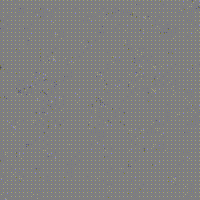Matching a target final wavefield¶
In addition to calculating the gradient with respect to the velocity model of a loss function involving the receiver amplitudes, Deepwave can also calculate gradients involving any of the propagation outputs with respect to any of the float tensor inputs. So the Born scalar propagator, for example, supports calculating gradients not only with respect to the scattering potential, but also with respect to the velocity model and source. This can involve multiple inputs and outputs of a propagation simultaneously, so you can calculate the gradient with respect to multiple inputs (say velocity and source amplitudes) of a loss function that involves multiple outputs (such as receiver amplitudes and final wavefield amplitudes).
In previous examples we have seen several demonstrations of typical optimisations of the velocity model or scattering potential to reduce the difference between predicted and observed data. This time, let’s optimise source amplitudes to make the final wavefield match a target.
We will use this image as a target:

We can load it using:
target = torchvision.io.read_image(
'target.jpg',
torchvision.io.ImageReadMode.GRAY
).float()/255
target = (target[0] - target.mean()).to(device)
Let’s create n_sources_per_shot sources located at random cells, without more than one at the same location:
source_locations = torch.zeros(n_shots, n_sources_per_shot, 2,
dtype=torch.long, device=device)
torch.manual_seed(1)
grid_cells = torch.cartesian_prod(torch.arange(ny),
torch.arange(nx))
source_cell_idxs = (
torch.randperm(len(grid_cells))[:n_sources_per_shot]
)
source_locations = (
grid_cells[source_cell_idxs]
.reshape(1, n_sources_per_shot, 2).long().to(device)
)
The next step is to then create the initial source amplitudes and specify that we want to calculate gradients with respect to them:
source_amplitudes = (
deepwave.wavelets.ricker(freq, nt, dt, peak_time)
.repeat(n_shots, n_sources_per_shot, 1).to(device)
)
source_amplitudes.requires_grad_()
optimiser = torch.optim.LBFGS([source_amplitudes])
The optimisation loop is then not very dissimilar to earlier examples. We’ll set the PML width to be zero on all sides so that waves reflect from the edges of the model. The loss function measures the difference between the final wavefield and the target image, and also penalises the norm of the source amplitudes to find the minimum norm solution:
def closure():
optimiser.zero_grad()
out = deepwave.scalar(v, dx, dt,
source_amplitudes=source_amplitudes,
source_locations=source_locations,
pml_width=0)
y = out[0][0]
loss = loss_fn(y, target) + 1e-3*source_amplitudes.norm()
loss.backward()
return loss.item()
for i in range(50):
optimiser.step(closure)
Lastly, we will save the wave propagation time steps so that we can make them into an animated GIF. The full example code shows two ways of achieving this. The simplest is to use Deepwave’s callback feature. The other uses the approach discussed in the checkpointing example.
Using FFmpeg to join these individual time steps into an animated GIF (although you could use other tools, such as Matplotlib):
ffmpeg -i wavefield_%03d.jpg -framerate 30 example_target_wavefield.gif
we obtain the result:
